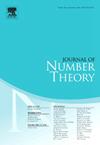A universal lower bound for certain quadratic integrals of automorphic L–functions
IF 0.7
3区 数学
Q3 MATHEMATICS
引用次数: 0
Abstract
Let π be a cuspidal unitary representation od where denotes the ring of adèles of . Let be its L-function. We introduce a universal lower bound for the integral where s is equal to 0 or is a zero of on the critical line. In the main text, the proof is given for and under a few assumptions on π. It relies on the Mellin transform; the proof involves an extension of a deep result of Friedlander-Iwaniec. An application is given to the abscissa of convergence of the Dirichlet series . In the Appendix, written with Peter Sarnak, the proof is made unconditional for general m.
某些自动 L 函数二次积分的通用下界
设 π 是一个尖顶单元表示 od GL(m,A),其中 A 表示 Q 的阿代尔环。我们引入了积分∫-∞+∞|L(12+it,π)12+it-s|2dt 的普遍下界,其中 s 等于 0 或为临界线上 L(s) 的零点。在正文中,我们给出了 m≤2 和 π 的几个假设条件下的证明,它依赖于梅林变换;证明涉及弗里德兰德-伊瓦尼耶克的一个深层结果的扩展。它还被应用于狄利克特数列 L(s,π) 的收敛尾差。在与彼得-萨尔纳克(Peter Sarnak)共同撰写的附录中,证明了一般 m 的无条件性。
本文章由计算机程序翻译,如有差异,请以英文原文为准。
求助全文
约1分钟内获得全文
求助全文
来源期刊

Journal of Number Theory
数学-数学
CiteScore
1.30
自引率
14.30%
发文量
122
审稿时长
16 weeks
期刊介绍:
The Journal of Number Theory (JNT) features selected research articles that represent the broad spectrum of interest in contemporary number theory and allied areas. A valuable resource for mathematicians, the journal provides an international forum for the publication of original research in this field.
The Journal of Number Theory is encouraging submissions of quality, long articles where most or all of the technical details are included. The journal now considers and welcomes also papers in Computational Number Theory.
Starting in May 2019, JNT will have a new format with 3 sections:
JNT Prime targets (possibly very long with complete proofs) high impact papers. Articles published in this section will be granted 1 year promotional open access.
JNT General Section is for shorter papers. We particularly encourage submission from junior researchers. Every attempt will be made to expedite the review process for such submissions.
Computational JNT . This section aims to provide a forum to disseminate contributions which make significant use of computer calculations to derive novel number theoretic results. There will be an online repository where supplementary codes and data can be stored.
 求助内容:
求助内容: 应助结果提醒方式:
应助结果提醒方式:


